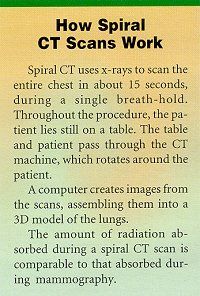NCI Tests Feasibility of Large Study of Lung Cancer Screening
BETHESDA, Md-The National Cancer Institute has launched a randomized, 3,000-person study to determine the feasibility of doing a larger scale trial to test whether spiral CT screening improves lung cancer survival. Six centers began recruiting volunteers in early September and hope to enroll 500 subjects each by the end of October.
BETHESDA, MdThe National Cancer Institute has launched a randomized, 3,000-person study to determine the feasibility of doing a larger scale trial to test whether spiral CT screening improves lung cancer survival. Six centers began recruiting volunteers in early September and hope to enroll 500 subjects each by the end of October.
Researchers will randomly assign participants to receive either a spiral CT scan or a chest x-ray. One goal of the year-long, $3 million Lung Screening Study (LSS) is to learn whether people at high risk for lung cancer will enter a trial in which they might not receive spiral CT.

The LSS will also compare the lung cancer detection rate for each of the two screening tests; determine the kind and the amount of medical follow-up that is needed for positive or ambiguous results; and track whether and how often participants get CT scans outside the study. Subjects must be age 55 to 74 and have a history of long-term or heavy smoking. Former smokers must have ceased smoking within the last 10 years.
In a relatively quick time frame, we will learn if smokers are willing to be randomized to receive something other than spiral CT, said principal investigator John Gohagan, chief of NCIs Early Detection Research Group in the Division of Cancer Prevention. We will also learn about the medical follow-up of people who have the scanshow extensive and expensive it tends to be.
No screening procedure for lung cancer, including spiral CT scanning, has been proven to increase survival. Yet despite this fact, many cancer specialists doubt the willingness of smokers to accept a screening test other than spiral CT.
ELCAP Data
Data from the New York-based Early Lung Cancer Action Program (ELCAP), first reported last year, showed that spiral CT screening of 1,000 smokers and former smokers age 60 and over detected suspicious lung lesions in 233 participants. Of these, 27 were diagnosed with lung cancer, 85% of which were stage I tumors. The findings attracted media coverage and caused a number of radiology centers to offer and advertise the procedure as a screening test.
Claudia I. Henschke, MD, PhD, who leads ELCAP, and an international group she helped organize now plan to conduct larger studies of spiral CT screening in people at high-risk of lung cancer. The expanded ELCAP trial and the international study will each enroll 10,000 participants. As with the original ELCAP, these are both single-arm trials.
NCI said that a randomized study to prove whether spiral CT scanning can increase survival would be expensive and require tens of thousands of participants and 5 or more years. Thorough review of results from the LSS will help researchers decide whether such a study is feasible.
PLCO Structure
The LSS is using the scientific structure established for the 150,000-participant Prostate, Lung, Colon, and Ovarian Cancer Screening Trial (PLCO), which NCI began in 1992. The six centers involved in LSS are also part of the PLCO study. NCI chose them because of their experience in recruiting and tracking volunteers in cancer screening trials.
Board-certified radiologists will review all the results from the LSS screening exams, and participants and their physicians will be notified of the results within 3 weeks. Those with positive chest x-rays will receive a recommendation for standard follow-up care. Because there is currently no standard follow-up for positive CT scans, participants with positive scans will be advised to see their primary care physician and to consult a specialist.
The centers participating in LSS are Georgetown University Medical Center/Lombardi Cancer Research Center; the Detroit-based Henry Ford Health System; the University of Minnesota School of Public Health/Virginia L. Piper Cancer Institute; Washington University School of Medicine; Marshfield Medical Research and Education Foundation in Wisconsin; and the University of Alabama at Birmingham.